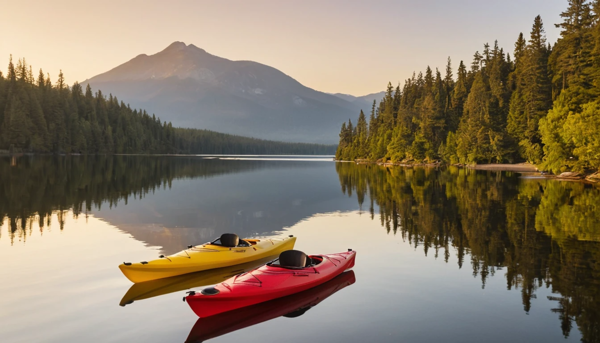Sit On Top vs Sit In Kayak – Learn the key differences, pros, and cons to find the perfect kayak for comfort, safety, and adventure.
The main difference between a sit-on-top and sit-in kayak is design and comfort. Sit-on-tops are open, stable, and easy to enter, great for beginners. Sit-in kayaks are enclosed, faster, and better for colder waters. Choosing depends on comfort, water type, and personal goals.
Have you ever stood at the edge of a dock and wondered: Should I get a sit-on-top kayak or a sit-in kayak?
🚣 Choosing between the two isn’t always easy. Each style has its own strengths, quirks, and best uses. Let’s break it down in a way that feels like we’re chatting over coffee—clear, friendly, and practical.
🌊 Understanding the Basics of Kayak Types
Kayaks come in two main types: sit-on-top and sit-in. A sit-on-top kayak has an open deck, so you sit on top of the boat. A sit-in kayak has a closed cockpit, where you sit inside with your legs under the deck. Both are designed for different paddling experiences.
For beginners, the open style of a sit-on-top feels less intimidating. It’s easy to hop on and off, even in deeper water. In contrast, a sit-in kayak feels more secure once you’re inside. It shields your legs from wind and splashes, making it a favorite in colder conditions.
🚣 Sit-On-Top Kayak Explained
A sit-on-top kayak has a molded seat on the deck. Instead of climbing into the kayak, you just sit on top of it. The design makes it more stable and beginner-friendly.
These kayaks usually feature scupper holes that drain water automatically, so you won’t have to worry about bailing. The open layout gives you more freedom to move around. That’s perfect for fishing, casual paddling, or sun-soaked days at the lake.
🛶 Sit-In Kayak Explained
A sit-in kayak places you inside the cockpit with your legs under the deck. It offers more control because your body connects closely with the boat. This makes paddling smoother and faster.
Since you’re shielded by the hull, you stay warmer and drier, even in choppy waters. Many sit-in models allow you to attach a spray skirt, which keeps water out entirely. That’s why they’re often used for touring and colder environments.
⚖️ Key Differences Between Sit-On-Top vs Sit-In Kayak
Here’s a quick breakdown to see how these two kayak types compare side by side:
| Feature | Sit-On-Top Kayak | Sit-In Kayak |
| Stability | High, great for beginners | Moderate, more skill required |
| Speed | Slower | Faster and more efficient |
| Comfort | Open, easy access | Enclosed, warmer |
| Best Use | Lakes, casual paddling, fishing | Touring, rivers, colder water |
| Self-Rescue | Easy | Harder without training |
🌞 Pros of Sit-On-Top Kayaks
- Easy entry and exit, even in deep water.
- Self-bailing design keeps water from pooling.
- Very stable, less likely to tip over.
- Great for warm climates and recreational use.
- Comfortable for people who dislike tight spaces.
- Versatile for fishing, swimming, or casual exploring.
- Fun, carefree, and beginner-friendly.
❌ Cons of Sit-On-Top Kayaks
While sit-on-top kayaks are great for beginners, they have some drawbacks:
- You get wet more often, even in calm waters.
- They’re heavier than most sit-in models.
- Slower and less efficient for long trips.
- Limited gear storage compared to sit-ins.
- Wind affects them more because of higher seating.
- Less protection in cold water conditions.
- Not ideal for serious touring or racing.
🌬️ Pros of Sit-In Kayaks
- Faster and more efficient paddling.
- Keeps you warmer and drier in cool weather.
- Better gear storage for long trips.
- Lower center of gravity improves control.
- Ideal for touring, rivers, and ocean paddling.
- Spray skirt option for extra protection.
- Feels more connected and secure.
❌ Cons of Sit-In Kayaks
- Harder to exit in case of a capsize.
- Self-rescue is more challenging without training.
- Less stable for beginners.
- Can feel cramped for larger paddlers.
- Not as versatile for swimming or fishing.
- Requires more skill to handle.
- Can collect water inside if not sealed properly.
🏞️ Best Situations for Sit-On-Top Kayaks
Sit-on-top kayaks shine in warm, calm conditions. They’re perfect for lakes, easy rivers, or coastal bays. If you’re looking to paddle casually, fish, or jump in and out for a swim, this style is unbeatable.
Families also love them because they’re safe for kids. If you fall off, climbing back on is quick and simple. Plus, beginners don’t need lessons to feel comfortable paddling.
🌊 Best Situations for Sit-In Kayaks
Sit-in kayaks work best in cooler climates or for long-distance paddling. They’re ideal for people who value speed and efficiency. Touring across lakes, exploring rivers, or tackling ocean conditions is much easier in a sit-in kayak.
If you plan on camping trips, sit-ins offer storage compartments for gear. They’re also a great choice for paddlers who want more control and better tracking in the water.
🎣 Fishing From Sit-On-Top vs Sit-In Kayak
Fishing feels easier on sit-on-top kayaks because you can move freely. Many models even include rod holders and gear mounts. Standing up or casting sideways isn’t a problem.
Sit-in kayaks, however, provide more protection from the elements. That’s useful in colder waters. But their limited movement can make fishing less convenient compared to sit-on-top designs.
❄️ Weather Considerations
Weather plays a big role in your decision. Sit-on-top kayaks are best in sunny, warm conditions where getting wet doesn’t matter. In contrast, sit-in kayaks are more comfortable in colder climates.
If you paddle in unpredictable conditions, a sit-in kayak with a spray skirt keeps you dry. That extra barrier against wind and waves is a lifesaver.
🧑🤝🧑 Comfort and Accessibility
Some people love the open freedom of sit-on-top kayaks. You can stretch your legs, move around, and hop off whenever you want. They also work better for taller or larger paddlers.
Sit-in kayaks, however, can feel restrictive. Yet, their enclosed design offers support for longer paddling sessions. The comfort level depends on your personal style and body type.
🚗 Transport and Storage
Sit-on-top kayaks are usually bulkier and heavier. They’re harder to lift onto a car roof rack. Sit-in kayaks, being sleeker, are easier to carry and transport.
Storage also matters. Sit-ins have sealed compartments for gear, while sit-on-tops often lack enclosed space. Think about whether you’ll need to carry extra supplies before deciding.
💰 Price Comparison
Here’s a simple look at pricing differences:
| Type | Average Price Range |
| Sit-On-Top Kayak | $250 – $900 |
| Sit-In Kayak | $300 – $1,500 |
Sit-on-tops are often cheaper, but advanced sit-in models for touring can get pricey. Your budget and paddling goals will help guide the choice.
📊 Who Should Choose Which?
| Paddler Type | Best Choice | Why |
| Beginner | Sit-On-Top | Stable and easy to use |
| Fisher | Sit-On-Top | Freedom of movement |
| Touring Enthusiast | Sit-In | Speed and storage |
| Cold Climate Paddler | Sit-In | Warmer and protective |
| Family with Kids | Sit-On-Top | Safe and beginner-friendly |
✅ Conclusion
Choosing between a sit-on-top vs sit-in kayak depends on your paddling style, climate, and goals. Sit-on-top kayaks are stable, fun, and perfect for beginners or warm weather. Sit-in kayaks are faster, efficient, and built for longer adventures in cooler conditions.
The bottom line? If you want casual fun, go sit-on-top. If you crave speed and touring, go sit-in. 🚣 Whichever you choose, the best kayak is the one that makes you excited to hit the water.
❓ FAQs: Sit On Top vs Sit In Kayak
- Which kayak is better for beginners?
Sit-on-top kayaks are usually better for beginners. They’re stable, easy to enter, and safe for warm water. Many people feel less nervous starting with this style. - Are sit-on-top kayaks safer than sit-in kayaks?
Both are safe when used correctly. Sit-on-tops are easier to re-enter after capsizing. Sit-ins require training but offer more protection in rough conditions. - Can you use a sit-in kayak in the ocean?
Yes, sit-in kayaks can handle ocean paddling. They track better and offer protection from waves. Always use a spray skirt for safety. - Do sit-on-top kayaks flip easily?
No, sit-on-top kayaks are very stable. Their wide design makes tipping rare in calm conditions. Beginners usually feel confident on them. - Which kayak is better for fishing?
Sit-on-top kayaks are better for fishing. They allow more movement, easy casting, and quick access to gear. Many models are built specifically for anglers.






Leave a Reply